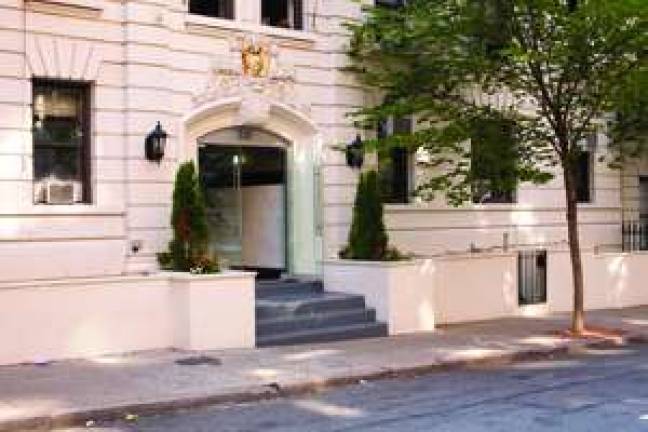Heightened Concerns After Fire at W. 95th Homeless Shelters

By Amanda Woods About a month after two transitional homeless shelters housing 200 homeless families opened on West 95th Street, some residents and local elected officials are still vocally opposed to the facilities. The two buildings-at 316 and 330 W. 95 St.-are on a residential block between West End Avenue and Riverside Drive. They serve as emergency shelters-opened because the city needed more beds to support the growing homeless population. Local residents argue that housing the homeless is not the intended purpose for the two buildings and that the neighborhood, already home to several other shelters, shouldn't have to take on another one. A nighttime fire that broke out Aug. 28 on the fourth floor of 316 W. 95th St. has heightened concerns for some about the facilities. Other residents are concerned about the shelters' close proximity to a school and a playground. Stephanie Martinez, 19, who lives with her family on the Upper West Side, is one such resident. "It's a bad idea," Martinez said. "I've been living here for 10 years, and my brother goes to school at P.S. 75. We don't know the backgrounds [of the shelter residents]." But one middle-aged man who was moving into one of the buildings last week with his son said that neighbors should think twice before complaining about the shelters. "I don't have empathy for the $100-250,000 per year homeowner," the man said. "The poor used to be up and down the street here. The rich get richer and the poor get poorer." But other residents and local electeds insist that it's far from a "not in my backyard" attitude that informs their opposition to the shelters. The concern is more about the type of buildings the homeless families are moving into, and who should live there. These are single-room occupancy buildings (SROs)-small individual apartments with a shared bathroom and kitchen. Some Upper West Siders say these buildings should be occupied by low-income rent payers-yet SRO owners and landlords are able to make much more money by renting the space to Homeless Services, which pays a monthly rent of $3,000 for each room. "The buildings should be for ordinary New York rent-paying people," said Avi, a neighborhood resident who declined to give his last name. "The buildings should not be fodder for real estate speculators who have managed to raise rents in this city to levels unaffordable to ordinary people." Upper West Side Councilmember Gale Brewer agrees, and she, along with other local leaders, voiced her opposition to Homeless Services even before the shelters opened up. "These buildings we want to be permanent housing," Brewer said. "We want similar residents who have longstanding community ties to be residents." Mark Diller, the chairperson of Community Board 7, said that the use of the SROs as homeless facilities is counterproductive when it comes to solving the overarching goal-reducing homelessness and building up the affordable housing stock for local residents. "The problem is that by the shelter taking up these units, you're eliminating 200 units of otherwise affordable housing," Diller said. "The SRO Law Project tries to make sure that what's left of the affordable housing stock is preserved. It's very troubling. ? You want everyone to be able to live permanently in the community. [You're creating] the problem that you're trying to solve." Assemblymember Linda Rosenthal, who represents the Upper West Side, shares Diller's viewpoint, adding that by placing the homeless in these buildings, the city is rewarding Robert Hess, a former DHS commissioner who now operates the shelters, for his multiple housing violations as a landlord. "This homeless problem is just made worse by the city recycling people into units that should be permanent housing, and rewarding someone who breaks the law," Rosenthal said. The middle-aged homeless man said that this year's elimination of the Advantage Program, a rental subsidy that helped to pay one or two years of rent support to eligible households, led to a sharp decline in the neighborhood's affordable housing. "There is no reasonable housing program, period," he said, adding that opponents of the West 95th Street shelters should advocate for affordable low-income housing in the neighborhood. According to the Fair Share Doctrine, each community must do its part in providing for the poor. Diller believes that the Upper West Side has more than its share of homeless residences: In the West 90s, the Narragansett, the Senate, Camden Hotel and Yale/Rose, to name a few, already provide housing for the homeless; and 21 percent of the city's vulnerable population is housed on the Upper West Side, Diller said. Because the 95th Street shelters are emergency transitional housing, Homeless Services was able to bypass its usual neighborhood Fair Share review. "This is us saying we've done our fair share several times over," Diller said. "They're using emergency certification as an excuse not to do the public review." Heather Janik, the DHS spokeswoman, said the agency is doing its part in communicating with the community. "Our Agency has a legal mandate to provide temporary, emergency shelter to homeless individuals in need, and opened a shelter on West 95th Street so that our clients can live and be served with dignity and respect," Janik said. "We have been actively communicating with elected officials from the beginning of this process and engaged in open dialogue with community leaders, and will maintain positive relations with residents in the surrounding neighborhood."